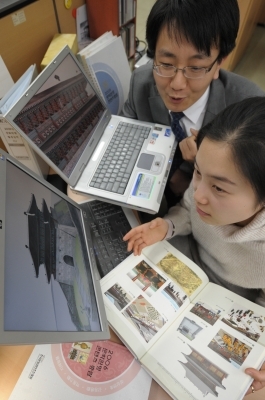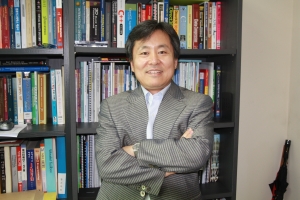
3D cultural heritage collectors have recently assembled in Kyungwon University with support from the Ministry of Culture, Sports, and Tourism to march in step with the movement of the Culture Technology Boom. The newly coined term, Culture Technology, often refers to the convergence of culture and technology, which are put together to form into a new business. The contents and gaming industries, therefore, are the most promising stars of Culture Technology today. However, what good is it if the technology cannot protect or renew the cultural heritage National treasures and cultural artifacts represent the history of culture, and their complete collection in the end becomes the country’s ultimate asset.
Culture Technology Institute of Kyungwon University
Since neither a single artist nor architect has been able to outlive their masterpiece, protection and preservation of their work has always been left up to the nation’s interest. Therefore, perhaps the first thing to secure in the Culture Technology Industry is keeping these cultural sites and national treasures in one piece. How many of them has Korea lost already The great misfortunes of Namdaemun and Naksan Temple have only proven that accidents are inevitable. This is why the collectors at the Culture Technology Institute of Kyungwon University have been working on a massive scanning project since July 2008.
The most sophisticated scanning in history has begun to file the nation’s cultural properties into a 3D database. By practicing 3I, which stands for interdisciplinary, intelligent, and integration with the school system, the CT Research Center of Kyungwon University strengthens the exchange of information between the government, companies, and research centers. Professor Whangbo Taegkeun added, “The documentation of architecture doesn’t only involve the recording of basic knowledge. Its history and fengshui are just the beginning for research possibilities. Collaboration, therefore, is key in this area.” Under the command of Dr. Whangbo Taegkeun, the Culture Technology Institute of Kyungwon University has devoted itself to developing high-tech intelligent tools that measure, analyze, repair, and apply cultural properties.
Digitalizing Cultural Artifacts in 3D

“Cultural artifacts and historic landmarks are now being digitally reborn in a 3D database,” said Whangbo Taegkeun, head of the Kyungwon University Culture Technology Institute. Dr. Whangbo is leading the institute to digitalize cultural assets that have come from ancestors dating back to more than two thousand years ago.
Once the works are scanned in 3D version, they will be organized in the database to be applied in many different ways. A sketch of the work can automatically be printed at the time of request, and an intelligent analysis will be conducted to find a home for the excavated piece of a broken artifact. “Currently, we have successfully digitalized 47 stone structures. Our next collection will be targeting the wooden relics of the country, which will be a challenge due to their delicacy,” said the head of the institute. The core technology here is a scanner that accepts data in three dimensions. This is still a fairly new concept. From 2004 to 2006, the Ministry of Information and Communication sponsored the Digital Heritage Exchange Forum in Korea and amassed related parties from Europe and Southeast Asia to exchange information. Since the termination of the ministry, Kyungwon University has taken charge to host the forum with an alliance of many other organizations including the National Museum of Korea, Ministry of Culture, Sports and Tourism, Korea Culture Contents Technology Association, University of Jeonju and KAIST.
Japan Digitalizing Other Country’s Cultural Heritages
Japan has recently shown an interesting move at the starting line of digital heritage. Japan's top leading companies like Hitachi and the government both have been making an aggressive investment to complete a digitalization of world-renowned sites and landmarks. Hitachi, as a result, is the only company in the world that has a sophisticated digital record of Angkor Wat in Cambodia. This foreshadows that the application of the 3D data will serve beyond restoration and protection. If a movie producer plans to use the digitalized 3D version of Angkor Wat, therefore, the only company to ask would be Hitachi.
“The Japanese government has recently rebuilt the Afghanistan’s stone Buddhist images based on the digitalized data they achieved before their destruction by the Taliban,” added Dr. Whangbo. While the Japanese government’s active investment is still carried on to digitalize world-renowned relics across the world, a three-year, 600 million won project to collect 3D data of all Korean cultural works is well under way with the full support of the government.
Beyond Restoration
“We are working closely with the National Research Institute of Cultural Heritage (NRICH) to commercialize our technology into commodities. NRICH is in the progress of making educational online games,” Professor Whangbo said. Kyungwon University Culture Technology Institute also collaborated with Sogang University to classify the stone towers by the historical periods. Here they distinguished the stone towers from one dynasty from the other dynasties. The researchers believe that digitalize Korea's cultural heritage can vitalize the upcoming contents industries as well as the education system.
Kyungwon Institute has worked for three years with archeologists to come up with this new technology. In order to use the technology, users have to digitalize the relics first. Namdaemun, Korea’s number one national treasure, was digitalized six months before it was burnt down by arson. Without this data, the accuracy and efficiency of restoration may have been an extreme challenge. Japan already has secured numerous 3D data of important world sites and artifacts. Such data will become priceless as time goes by. “Cultural assets will greatly contribute to the contents industry, and will soon come to represent the country’s competitiveness. Souvenirs, movies, games, and miniatures are only a few applications of 3D digitalization of cultural heritage,” said Dr. Whangbo.
An organized vision, a comprehensive plan, collaboration, and funds are only a few of the elements needed to succeed with the current 3D digital heritage project and take it to the next level. If all goes well, a clear glimpse of the past will reach computer screens worldwide in the near future.
“The digitalizing technology is only the beginning of what is required to maintain and repair cultural properties. Products like this which converge CT and IT will challenge the creation of professional cultural property companies, and further lead to the establishment of cyber museums,”said Professor Whangbo.


